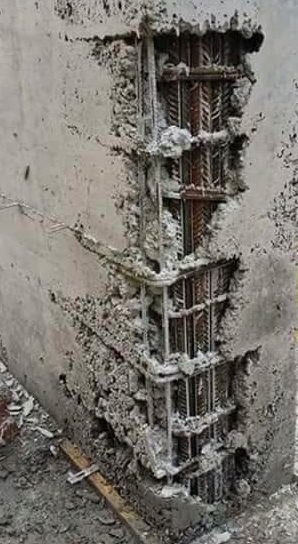Honeycombs in Concrete
Honeycombs in concrete are quite common in construction and there seems no construction work without honeycombed concrete. It should be noted that causing honeycombs in the concrete could lead to severe issues in the structures.
Let’s understand the honeycomb.
What is a Honeycomb in Concrete
Honeycomb is the result of poor compaction of the concrete and the formation of cavities in the concrete. Generally, honeycombs in concrete are formed closed to the surface of the concrete.
However, due to the congestion in the reinforcement arrangements, there are possibilities of forming cavities internally. Further, there is minimal chance of noticing internal cavities.
Causes of Honeycomb in Concrete
There are many causes of honeycomb in concrete that can be categorized based on the nature of the concrete, nature of the structure, and environmental conditions.
In this article, we are discussing the main reasons for honeycomb in concrete. let’s see what they are.
- Lack of workability of the concrete
Concrete should be adequately workable to pour. If the concrete is in a condition that is not moving or flowing in the usual manner, it could not be compacted well. Further, stiffer the concrete the same thing could occur.
This could cause the loss of the sump. The slump is an indication of the workability of concrete. Having a far distance between the batching plant and the concreting structure, use of a high range of water-reducing admixtures, etc could cause to loss of workability of concrete.
- Inadequate Vibration and Compaction
Lack of vibration could lead to uncompacted forming honeycombs. In addition, excessive vibration could also result in forming the honeycombs due to the segregation of concrete. Further, this can be considered as one of the main causes of honeycomb in concrete.
- Reinforcement Congestion
Conjected areas of the reinforced concrete structures are vulnerable to forming honeycombs. Inadequate space for concrete to flow could create internal as well as external honeycombs in concrete.
Poor reinforcement detailing could create the congestion of the reinforcements.
- Segregation
Concrete could segregate due to the falling height, congestion in the reinforcement, excessive vibration, etc. When the concrete segregates, an aggregate could separate from the grout can collect separately. This can be considered as one of the reasons for honeycomb in concrete.
- Inadequate Cover to the Reinforcements
If there is no adequate space to floor the reinforcement in the cover zone due to the conditions of the reinforcement, there could be places without the concrete.
Effects of Honeycomb in Concrete
This should be aware by all the design and construction engineers. Then everyone would take the necessary measures to avoid forming honeycombs.
- Loss of Strength / Reduction in the Structural Capacity
Formation of the honeycombed means there is a weak zone in the concrete. Improperly compacted, loosely bound aggregates will crush when the loads are applied if they are not repaired correctly.
Repairing honeycomb concrete shall be done with close supervision under the instruction of a good expertise technical personnel.
If the cavity remains the same or if the loosened part is not completely removed, it could lead to a structural failure in the load-bearing elements.
- Durability Issues
The durability of concrete is the foremost important aspect of a concrete structure. Loss of durability could cause the structures to deteriorate before their design life.
The following issues could be identified as the main effects of honeycomb concrete.
- Corrosion of reinforcements
- Deterioration of Concrete
When the rebar is exposed to the environment, it could corrode in the presence of moisture and oxygen. In addition, minor nature honeycombs in concrete also result in corrosion of reinforcement by chloride attack or carbonation of concrete.
- Water Leaks in Water Retaining Structures
Honeycomb on concrete could lead to leakage of water through the defective concrete elements. Unidentifed honeycomb on concrete surfaces will lead to damage to the waterproofing too.
How to Prevent Honeycombs in Concrete
- Reinforcement Detailing
Reinforcement detailing shall be done accommodation adequate space for the concrete to flow.
- Improve Workability of Concrete
Adequate flowability of the concrete shall be maintained. In the situation where the reinforcement connection exists, admixtures such as high rage water-reducing admixtures could be used.
- Maintain Adequate Gap between Bars
As per the BS 8110, it is required to maintain a minimum gap between bars as aggregate size +5 mm. If there is sufficient space for concrete to flow, it could reduce the formation of honeycomb on concrete.
- Adequate vibration and formwork vibration where necessary
Types of Honeycombs in Concrete
Honeycomb on concrete can be classified based on the size or based on the width of the honeycomb.
- The width of the honeycomb is around 25mm and the depth is also in the same rage
- The width and depth of the honeycomb is around 100mm
- The width and depth of the honeycomb is greater than 100mm
The size of the honeycomb is very important when deciding the rectification procedure and the degree of attention required during repairing honeycomb concrete.
The larger the honeycomb is higher the risk. Further, repairing could be done in stages to minimize the shrinkage.
Repairing Honeycomb Concrete
The following key aspect can be highlighted and it should also be noted that all the civil engineers shall be aware of how to treat honeycomb in concrete.
- Loosen material shall be removed completely.
- When the element to be repaired is loaded and the damage is major repairing honeycomb concrete shall be done with due care.
- Further, depending on the extent of the honeycomb, external supports could be required to reduce the load applied to the defective structural element.
- All the honeycombs shall be filled with non-shrink construction grouts.
- When the size of the honeycomb on concrete is larger (like 100mm or more) repairing shall be done in several stages as recommended by the material supplier.
- Further, when the volume required for repairing honeycomb concrete is higher, a 1: 1 mix of nonshrink construction grout and chip could be used as recommended by the grout supplier.
- Mixing time and procedure shall be as specified by the supplier.
- The content of water shall strictly be as specified in the specification of the construction grout.
- Adequate curing shall be done. Generally, the construction grout develops strength in the range of 50-60N/mm2 and it is rapid strength gaining process. Therefore, curing shall be done correctly.
This would clear you the question of how to treat honeycomb in concrete.





